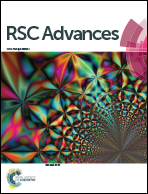Etching synthesis of iron oxide nanoparticles for adsorption of arsenic from water†
Abstract
Arsenic contamination in source drinking water has become an alarming issue worldwide. Iron oxides have been recognized as effective adsorbents for arsenic removal. In this study, an etching method was used to synthesize nanosized iron oxide with small primary particle sizes of approximately 4 nm and a high specific surface area of 317 m2 g−1. The material was used as an adsorbent for arsenic removal from water. The sorption isotherms fit the Langmuir equation, and the derived maximum sorption capability for As(III) and As(V) is 42 mg g−1 at pH 7 and 83 mg g−1 at pH 3, respectively. Arsenic adsorption obeys pseudo-second-order kinetics. The adsorption sites were located mostly on the external nanoparticle surface, and therefore intraparticle diffusion resistance was avoided and external diffusion was the rate-limiting step. The mechanism of arsenic removal on nanosized iron oxide is chemisorption via inner-sphere surface complexation, and the hydroxyl groups of arsenic species are important for reaction with adsorbent surface hydroxyl groups. Adsorption of As(III) in the presence of hydrogen peroxide and ferrous ion was also studied, and the catalytic oxidation of As(III) significantly promoted its adsorptive removal.


 Please wait while we load your content...
Please wait while we load your content...